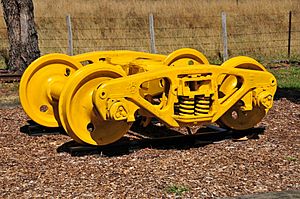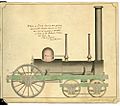Bogie facts for kids
A bogie (pronounced BOH-gee) is a special frame with wheels that attaches to a train car or a locomotive. In North America, this part is often called a truck. Think of it as the part that holds the wheels and helps the train move smoothly along the tracks. Each train car usually has two bogies, one at each end. Bogies typically have four or six wheels. They can turn a little bit, which helps the train go around curves easily.
Contents
What is a Train Bogie?
A bogie is much more than just a set of wheels. It is a complete assembly that includes the wheels, axles, and a strong frame. This frame connects directly to the main body of the train car. Bogies are super important because they help distribute the train's weight evenly. This makes the ride smoother and safer for passengers and cargo.
Why Do Trains Need Bogies?
Trains are very long and heavy, so they need a special way to connect to the tracks. Bogies provide this connection. They help the train in several ways:
- Spreading the weight: Bogies spread the heavy weight of the train car over many wheels. This reduces the pressure on the tracks.
- Smooth riding: They have suspension systems, like springs, that absorb bumps and shocks. This makes the journey much more comfortable for people inside.
- Handling curves: Without bogies, long trains would struggle to turn corners. Bogies allow each section of the train to flex and turn independently.
How Bogies Help Trains Turn
One of the most important jobs of a bogie is to help a train navigate curves. When a train approaches a bend in the track, the bogie can pivot or swivel slightly. This small movement allows the wheels to follow the curve of the track without forcing the entire train car to bend. It's like how the front wheels of a car turn to steer. This flexibility prevents the wheels from dragging or derailing, making train travel safe and efficient.
The Main Parts of a Bogie
Even though bogies look simple, they have several key parts that work together:
- Wheels and Axles: These are the parts that roll on the tracks. The wheels are fixed onto a strong bar called an axle.
- Bogie Frame: This is the main structure that holds everything together. It's usually made of strong metal.
- Suspension System: This includes springs and shock absorbers. They help to cushion the ride and reduce vibrations from the tracks.
- Brake System: Bogies also have brake components that help the train slow down and stop safely.
Different Types of Bogies
There are many different kinds of bogies, designed for various types of trains and uses. For example:
- Passenger Train Bogies: These are designed for comfort and high speeds. They often have advanced suspension systems to ensure a very smooth ride.
- Freight Train Bogies: These are built to be very strong and durable. They carry heavy loads and are designed for reliability rather than speed or comfort.
- Locomotive Bogies: The bogies on locomotives (the engines that pull the train) are often more complex. They might include motors that drive the wheels.
Bogies have been an important part of train design for a long time. The first rolling stock with a bogie was a locomotive built in 1832 by John B. Jervis. Over the years, bogies have been improved to make trains faster, safer, and more comfortable.
Images for kids
-
Front truck on Pacific Surfliner SC-44 #2116 at Santa Fe Depot.
-
The truck on an Amtrak GE Genesis P42DC locomotive. The paint scheme is Phase V.
-
Side view of a SEPTA K-Car bogie
-
Diamond frame bogie, elliptical springs and American style journal boxes
-
Diamond frame bogie, coil springs and journal boxes
-
Bogie of an SBB Eurocity passenger car, as seen from underneath
-
Anheuser-Busch refrigerated rail car on archbar freight trucks
-
North American Bettendorf-style "three piece bogie" with coil springs and (now obsolete) journal boxes displayed at the Illinois Railway Museum.
See also
 In Spanish: Bogie para niños
In Spanish: Bogie para niños




























